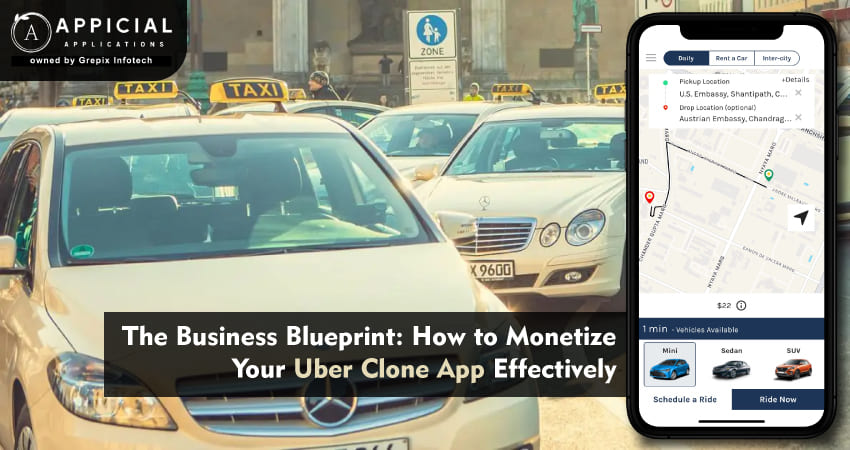
The Business Blueprint: How to Monetize Your Uber Clone App Effectively
In the ever-evolving landscape of urban mobility, the demand for flexible, user-friendly, and economically viable transportation solutions is growing exponentially. We are thrilled to introduce Indirver clone app, a groundbreaking feature set to revolutionize the way fares are determined within our app. As a leading innovator in the transportation industry, we understand that flexibility and fairness are key to customer satisfaction and driver fairness. That’s why we’ve developed Indirver—a dynamic new tool designed to empower both passengers and drivers by facilitating real-time fare negotiations before a ride is confirmed.
In the era of digital transformation, ridesharing apps like Uber have not only disrupted traditional transportation industries but have also paved the way for entrepreneurs to explore similar ventures. Creating an Uber clone app offers a promising pathway to tap into this lucrative market. However, the success of such an endeavor doesn't solely depend on technology or user interface design; the crux lies in effectively monetizing the application. This blog aims to serve as a comprehensive guide for entrepreneurs who aspire to launch and profitably run their own Uber clone app. We will delve into a variety of monetization strategies that leverage market dynamics, innovative technologies, and customer engagement to help transform your ambitious digital ride-sharing project into a thriving business.
Here, we’ll explore various monetization tactics that can transform your Uber clone app into a profitable business.
This blog outlines effective monetization strategies for Uber clone apps, essential for entrepreneurs aiming to penetrate the lucrative ridesharing market. It emphasizes the importance of understanding market dynamics, including demographic insights and competitive analysis, to tailor services effectively. The blog advocates diversifying revenue through multiple channels such as commissions, surge pricing, subscriptions, and advertising. Enhancing user experience through technological integration like AI, ML, and data analytics is crucial. Additionally, strategic partnerships and careful expansion can further drive growth. Overall, the blog serves as a comprehensive guide to transforming a rideshare app into a profitable, scalable business.
1. Understanding the Market Dynamics
Before launching any business, especially one as customer-focused as a rideshare app, understanding the market dynamics is paramount. This foundational step is not just about identifying a target market, but also involves analyzing several key factors that will dictate your app’s operation and potential profitability. Here’s how you can thoroughly understand the market dynamics for your Uber clone app:
- Demographic and Geographic Insights: Start by identifying who your users are and where they are located. Are you targeting busy professionals in urban areas, or perhaps residents in less densely populated regions where public transportation is sparse? Understanding these aspects will help you tailor your services to the needs of your specific audience.
- Competitor Analysis: Study your competitors thoroughly. Who are the major players in your targeted area? What services do they offer? What are their pricing strategies? Analyzing your competition not only helps you find your unique value proposition but also enables you to learn from the successes and failures of existing services.
- Regulatory Environment: Each region has its own set of regulations governing transportation services. It’s crucial to understand these legal requirements and ensure your app complies with all local laws. This might include obtaining necessary licenses, adhering to data protection policies, and more.
- Market Trends: Stay updated with the latest trends in the rideshare market. This includes shifts in consumer behavior, technological advancements, and economic factors that could influence demand. For instance, an increasing focus on sustainability might drive demand for electric vehicle ridesharing services.
- Economic Factors: The overall economic environment can significantly affect your business. Factors such as the local economic status, fuel prices, and the purchasing power of your target demographic will influence your pricing strategies and service offerings.
- Customer Preferences: Today’s consumers are looking for more than just convenience. They value privacy, safety, and affordability. Understanding these preferences and incorporating features that address them can set your app apart from competitors. This might include offering female-only rides, premium services, or loyalty programs.
- Technological Penetration: Gauge the level of technological adoption in your targeted area. The success of a rideshare app depends highly on the users' comfort with mobile technology and internet penetration in the area. Tailoring your tech offering to match local capabilities and enhancing user experience accordingly is crucial.
2. Diverse Revenue Streams
To ensure financial sustainability and growth, diversifying revenue streams is essential for any Uber clone app. Relying on a single source of income can be risky, especially in the dynamic and competitive environment of ridesharing. Here are several strategies to create multiple revenue channels that can help stabilize and increase your app's earnings:
- Commission Model The most common revenue model for rideshare apps is to take a percentage of each fare as a commission. This rate can vary, typically ranging from 15% to 25%, depending on the local market conditions and competitive pricing. This model provides a steady income as long as there are active rides being booked through the app.
- Surge Pricing Implementing dynamic pricing during peak times is a strategic way to maximize earnings. Surge pricing incentivizes drivers to be available during high-demand periods, thereby increasing the supply to meet the surge in demand. This not only boosts revenue but also ensures customer satisfaction by reducing wait times.
- Subscription Models Offering subscription packages can be an excellent way to guarantee steady revenue. Subscribers might pay a monthly fee to access perks such as discounted rates, zero surge pricing, or faster pickup times. This model appeals to regular users and can enhance customer loyalty and predictability in income.
- Advertisement Monetizing the app through targeted ads is another viable revenue stream. By partnering with local businesses or brands that align with your user demographics, you can display ads in the app. These could be banner ads, interstitials, or sponsored content. It's crucial to balance advertising to avoid disrupting the user experience.
- Corporate Tie-ups Establishing partnerships with local businesses or corporations can secure a consistent user base. Companies may look to rideshare apps to provide transport solutions for their employees, offering a regular and reliable income stream for the app.
- Premium Offerings Introducing luxury services with high-end vehicles can attract a niche market willing to pay more for superior comfort and exclusivity. This segment may offer higher profit margins compared to standard rides.
Also Read: Building Your Own Dating App: A Step-by-Step Guide
3. Enhancing User Experience
In the competitive landscape of ridesharing apps, the user experience (UX) can be a major differentiator. An outstanding UX not only attracts new users but also retains existing ones, ultimately driving more revenue. Here are strategic ways to enhance the user experience in your Uber clone app:
- Multiple Payment Options Flexibility in payment methods caters to user convenience and preference. Incorporate a variety of payment options including credit/debit cards, mobile wallets, and perhaps even options like PayPal or cryptocurrency to cover a broader user base.
- Loyalty Programs Flexibility in payment methods caters to user convenience and preference. Incorporate a variety of payment options including credit/debit cards, mobile wallets, and perhaps even options like PayPal or cryptocurrency to cover a broader user base.
- Quality Control Maintaining high standards for drivers and vehicles enhances customer satisfaction and retention. Implementing a rigorous onboarding process for drivers and regular quality checks can help in building a reliable brand.
4. Leveraging Technology
In the fast-evolving world of ridesharing, harnessing cutting-edge technology is key to gaining a competitive edge and enhancing overall user satisfaction. An Uber clone app, equipped with the latest technological advancements, can not only improve operational efficiency but also deliver superior customer experiences. Here are several ways to effectively leverage technology in your Uber clone app:
- Data Analytics Use data analytics to understand user behavior, optimize routes, and personalize marketing strategies. Insights from data can help you tailor your services to better meet the needs of your customers and operate more efficiently.
- AI and Machine Learning Integrate AI and ML to refine various aspects of your service. For example, predictive analytics can be used to forecast ride demands, enabling dynamic pricing and better fleet management. AI can also power advanced features like automated customer service chatbots that provide instant responses to user queries.
- Internet of Things (IoT) Implement IoT solutions to improve vehicle management and safety. Connected devices can monitor vehicle conditions and provide real-time data to drivers and fleet operators about maintenance needs or potential issues, thereby preventing breakdowns and delays.
5. Strategic Partnerships and Expansion
For any business, especially in the competitive ridesharing market, strategic partnerships and thoughtful expansion are crucial for scaling and maintaining competitive advantage. For an Uber clone app, these strategies can open up new markets, diversify revenue streams, and enhance the service offering. Here’s how to approach partnerships and expansion effectively:
- Local Partnerships Forge partnerships with local businesses such as restaurants, entertainment venues, and retail shops. These partnerships can offer mutual benefits, such as promotional deals for customers who use your service to reach their locations. This not only drives customer traffic to partnering businesses but also increases ride bookings for your app.
- Geographic Expansion Once your business model is proven in one region, consider geographic expansion to untapped markets. Each new area will require adjustments to the local market conditions, but a successful template can be adapted and replicated.
Conclusion
In conclusion, as a leading taxi app development company, we understand that launching an Uber clone app is an ambitious endeavor. However, the journey from development to profit-making involves strategic planning and smart execution. Monetizing such an app requires a multifaceted approach that goes beyond simply copying the Uber model. By embracing diverse revenue streams, enhancing user experience, leveraging the latest technology, and forming strategic partnerships, you can significantly increase your app's potential for success.
Each of these strategies—from implementing dynamic pricing models and subscription services to integrating advanced analytics and expanding into new markets—plays a critical role in building a robust business. They not only contribute to the financial health of your enterprise but also enhance its operational efficiencies and customer satisfaction levels.
Remember, the goal is to not only enter the market but to thrive in it. This means continuously adapting to changes in technology and consumer behavior, and innovating in ways that meet the needs of users and drivers alike. With the right approach, your Uber clone app can become more than just a rideshare service; it can transform into a comprehensive mobility solution that stands out in the global marketplace.
We invite you to leverage our expertise and resources to create an Uber clone app that is efficient, scalable, and profitable. Let's drive forward together, turning innovative ideas into practical solutions that move people, support communities, and grow businesses.







